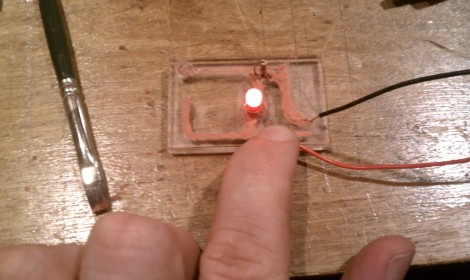
This glowing LED is proof that the experiments [Nvermeer] is doing with conductive ink are working. We’re filing this one as a chemistry hack because you need to hit the lab ahead of time in order to get the conductivity necessary for success. He reports that this technique uses a copper powder suspended in an epoxy intended for spray painting. Before mixing the two he etched the powder in ammonium persulfate, then washed it in deionized water which made it a much better conductor.
We gather that the ink was applied with the brush seen in the photo. But since this uses that spray paint friendly solution to host the copper powder we wonder about stenciling with something like masking tape in order to spray the circuit paths onto the substrate.
There’s not too much info up yet, but [Nvermeer] does link to one of our other favorite conductive ink projects.















That is awesome, nice work. I could use something like this to paint a circuit inside my welding helmet.
LED smiley face here I come :D
FYI glacial acetic acid takes oxide layers and such off of copper nicely without touching the copper metal underneath. Weird I know, but I tried it in my lab and it worked quite well.
Many acids remove the oxide layer, but that has not been sufficent to produce a conductive ink. The paper I linked to recommended etching the surface of the copper to smooth the surface and improve the chances of getting close packing of the copper spheres.
I would think to make the paths conductive you will have to make it too high a viscosity that it would not work in a spray gun. Seems like silk screening would be ideal.
Yeah, I was thinking the same thing. Use silk screening. But I wonder what the resistance of this stuff is like. I wonder if the traces need to be of a certain width and the layer needs to be a certain thickness.
Too bad you’d never be able to solder to it.
You might not be able to solder to it, but you should be able to attach components to it using conductive glue.
Now if only that conductive ink could be coaxed to work with an inkjet printer.
I wasn’t planning on trying to spray this ink, I was just testing a different binder.
I have not tried screen printing, but what has worked so far is etching a circuit into an acrylic sheet and then filling the etched traces in with ink.
Acetic acid, heh.
Nice hack, this guy should write a paper on his work and send it into EPE or Practical Wireless etc because this certainly has applications for homemade antennas at >500 MHz.
Also could be handy for putting SMD LEDs on bicycle helmets without compromising safety as the top coating and underlying foam is unaffected.
Always wondered if all the really good H-a-D projects could make it into a monthly web magazine, paid for by crowdfunding or donation.
So you pay $whatever you think the magazine is worth and get your own personalised downloadable copy or for a little more a printed version complete with schematics and code.
+1
I would be interested in seeing this progress.
Relume technologies holds doing this on a metal substrate with dielectric. It is patented for use with LEDs. Relume.com